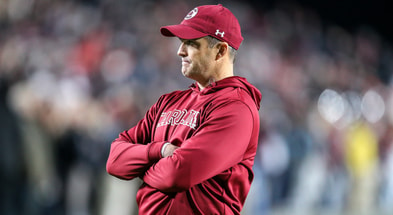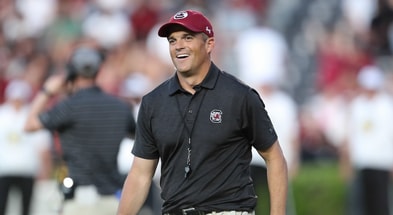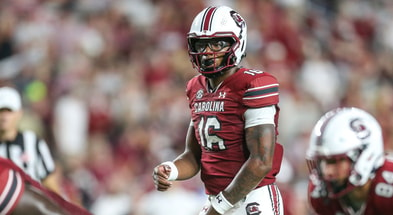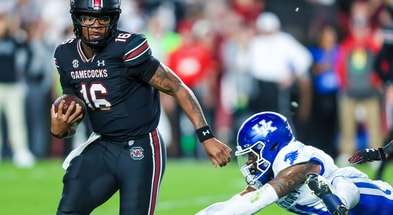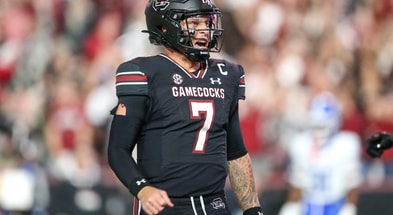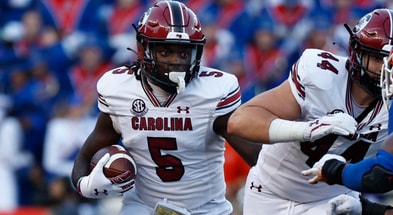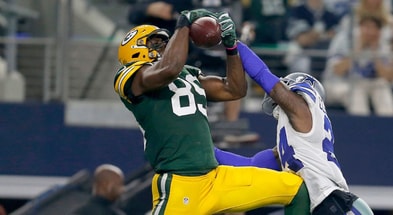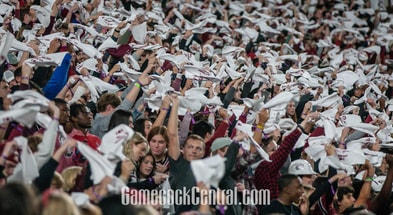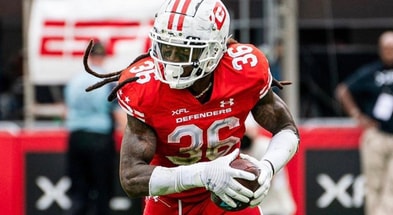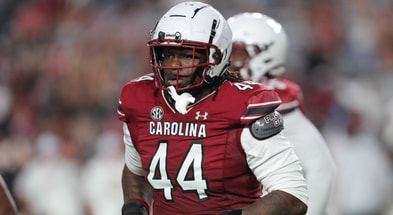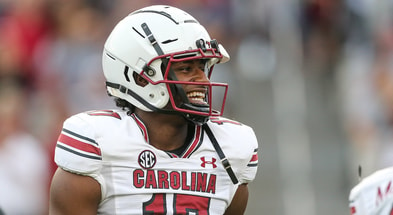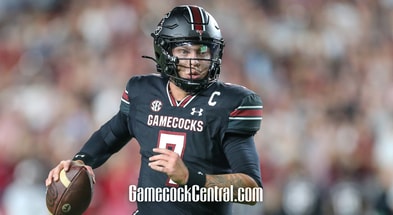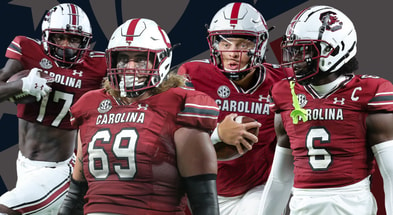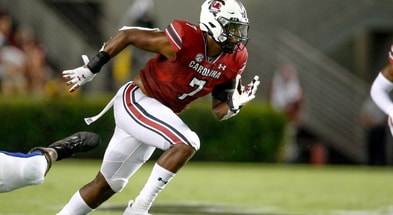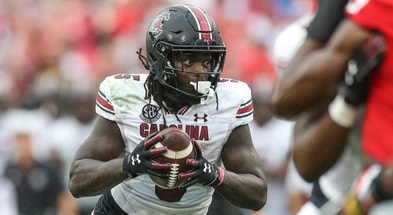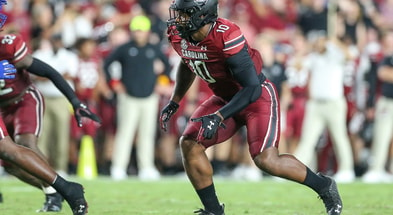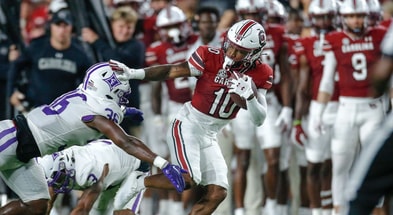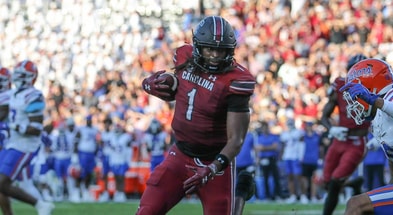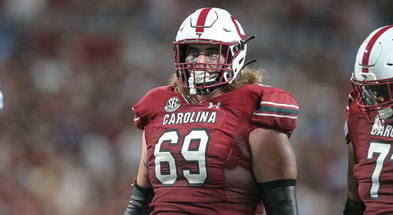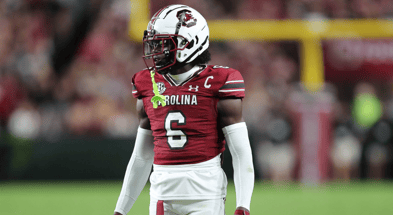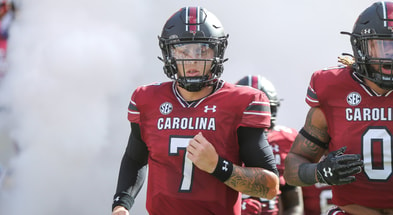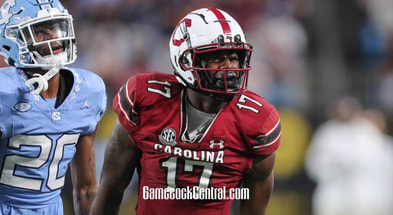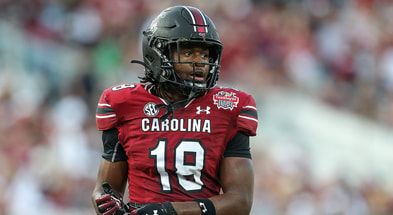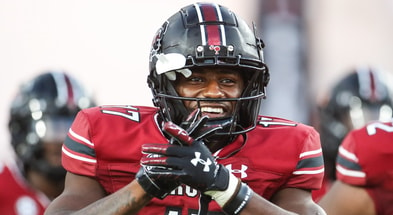Recalling South Carolina's role in the SEC/ACC expansion drama of 1990
Amid the wild conference upheaval unfolding, it is worth looking back at South Carolina’s far-from-uncertain path toward Southeastern Conference membership in the summer of 1990. What follows is a brief excerpt from the forthcoming book, A Gamecock Odyssey – University of South Carolina Sports in the Independent Era, due for release by USC Press on Nov. 14.
GamecockCentral readers can use the code JPIERCY30 to receive a 30% discount on orders of the book through Dec. 31, 2023, through USC Press.
By 1989, after the better part of two decades as a major independent, the University of South Carolina’s athletics department faced unprecedented financial headwinds. After years of operating in the black, USC reported a $600,000 deficit for fiscal year 1988-89. The deficit was fueled by numerous unanticipated expenses, including $300,000 to add structural supports to the upper-east deck of Williams-Brice Stadium, the cost of replacing “The Bubble” indoor practice facility after it was destroyed by hurricane Hugo in September of that year, a $232,000 settlement for former athletics director Bob Marcum and associated legal fees, plus expenditures from the internal investigation into the Joe Morrison-era steroids scandal, totaling over $300,000.
To compound matters, USC had only one televised football game during the 1989 season (Clemson), as conferences increasingly monopolized television outlets, choking off a major source of revenue for non-conference affiliated schools like South Carolina.
In fits and starts, South Carolina had sought a return to an all-sports conference home almost from the time it left the ACC in 1971. On-again, off-again back-channel talks with the ACC had narrated most of those efforts over two decades. South Carolina was, after all, a founding member of that conference, and many within the university community still believed it was the natural fit for USC.
The path toward reunification with the ACC seemed all but permanently blocked after Georgia Tech replaced USC as the eighth conference member in 1978, but with expansion rumors heating up in the late 1980s, the door seemed to crack open once again. By the spring of 1990, other options entered the discussion as well.
Writing for The State on May 20, 1990, Bob Gillespie explored the possibility of the Metro Conference adding football, among other options for USC. Since 1983, the Metro had been a viable, if not entirely preferable, conference home for South Carolina. In some ways, the Metro offered the best of both worlds, with South Carolina keeping 100% of the revenue from seven home football games, while conference affiliation provided a vehicle for earning NCAA basketball tournament bids and a home for non-revenue team sports. But with the rising costs of athletics and the need to generate income, maintaining an independent status in football was increasingly unsustainable.
Gillespie suggested five paths forward for USC:
- The ACC, USC’s former conference home. Many still thought this the most natural fit
- The SEC, the option preferred by some who believed it a better cultural fit for football-first South Carolina
- The Eastern Seaboard Conference, a new conference model first proposed by Penn State’s Joe Paterno – a confederation of major independent schools, including Penn State, West Virginia, Virginia Tech, Florida State, Miami, and South Carolina
- An expanded Metro Conference of 10 to 16 teams, which would include football
- Maintaining independent status in football, with Metro affiliation in all other sports
A reader poll in The State published two days later revealed a strong fan preference for the ACC, which garnered 62.2% of votes. The SEC was a distant second at 24.6%. Fans largely dismissed the Eastern Seaboard proposal, which accounted for only 4.3% of votes. The Metro options barely registered.
The Metro Conference had recently commissioned Raycom Sports to conduct a study into the viability of football scenarios for the conference. The study recommended conference expansion by at least two schools in order to make football an economically viable option for all members, with the preferred options being West Virginia and Miami. At their spring 1990 meeting, representatives from the Metro took the concept further, proposing a “Super 16” expanded Metro. Schools targeted for membership included Miami, Syracuse, Pittsburg, Boston College, East Carolina, Rutgers, West Virginia, and Temple.
With the proposed expansion, twelve schools would play all sports, while three (Syracuse, Pitt, and Boston College) would play football only, remaining in the lucrative Big East for basketball and other sports. East Carolina would also play football only and remain in the Colonial Athletic Association for all other sports.
Conference officials boasted the expanded Metro would capture over a third of American television markets, though critics called that overly optimistic. Boston College and Syracuse, for example, would not deliver a sizeable portion of the Boston and New York markets, given those city’s many sports options, including over a dozen professional teams in the four major sports.
Still, Metro officials were eager to make bold moves in the hopes of retaining member institutions ripe for the picking by expanding all-sports conferences, primarily South Carolina and Florida State. The Metro also faced possible defection from Cincinnati, Louisville, and Memphis State, which were in talks to join DePaul and Marquette to form a Midwest-based basketball conference if the Metro did not expand to include football, thus delivering them much-needed revenue sharing.
For USC athletics director King Dixon, Metro Conference football was a non-starter. “I’m not comfortable with the eight (schools) we have going to football,” Dixon told The State’s Gillespie. “We need at least two to five more, and I’m not sure the schools we’d want would come in with the current alignment. Frankly, a lot of our fans aren’t going to be intrigued with a home-and-home series with some of these schools. There’s nothing wrong with them, but there’s no rivalry or relationship.”
Beyond the minimal appeal of Metro football for fans, the financials were tenuous at best for South Carolina and Florida State, and especially unattractive for prospective member Miami, who was the lynchpin for Metro Conference football viability.
In a May 21, 1990 article in The State, columnist Doug Nye broke down the numbers in a sobering look at the viability of an expanded Metro arrangement. According to projections, a Metro television package was projected to yield around $1.25M per conference team. Using real data from the 1989 season, Miami and FSU earned over $3M each from television appearances, all theirs to keep. Another prospective member, West Virginia, earned 1.5M, while South Carolina and Southern Miss earned around $250,000 each. All told, these five schools earned around $9M from football television appearances in 1989. Divided by ten teams (the current Metro, plus Miami and West Virginia), each would have received about $900,000 in 1989. Great for Louisville, Cincinnati, and Memphis State, but a losing proposition for Miami and FSU.
For USC, the option of maintaining the status quo was dead on arrival, and Metro Conference football was on life support. Meanwhile, Penn State accepted an invitation to join the Big Ten in the spring of 1990, effectively eliminating the Eastern Seaboard Conference option. With three of the five options all but gone, South Carolina looked with renewed focus to the ACC and the SEC.
ACC officials were initially coy amid rising media speculation of expansion. ACC Commissioner Gene Corrigan told The State’s Bob Cole in May 1990 the door was closed, “…not just where South Carolina is concerned, but expansion in any form.” Corrigan cited high demand for ACC basketball tournament tickets and the unwillingness of some within the conference to split that pie into more pieces. Some members, he said, had a “big problem” when the ACC expanded to eight teams with the addition of Georgia Tech in 1978.
Corrigan was effectively buying time with media dismissals of expansion talk while he worked to align unanimous support within the conference before moving forward. Some media outlets noted that Duke and Wake Forest were against expansion, and though it would have taken three member schools to block, Corrigan strove for a united front.
Meanwhile, on May 29, 1990, SEC presidents gave unanimous approval to expansion at the league’s spring meetings in Destin, Florida. Four teams – FSU, Miami, Arkansas, and South Carolina – were reported to be the top candidates.
Adding to the immediacy for expansion, Notre Dame’s unilateral deal with NBC to broadcast home games beginning with the 1991 season and Penn State’s pending move to the Big Ten removed those two schools from the College Football Association (CFA), a loose conglomeration of the country’s major conference member schools and major independents, with the exception of Big Ten and Pac Ten members.
Beginning in the late 1970’s CFA member schools wrested control of lucrative football broadcasts away from the NCAA, which, since the 1950s had exercised complete control of college football television rights. The NCAA wanted to limit broadcasts out of a concern that television would suppress game attendance, while CFA sought the freedom to negotiate and expand television rights.
With Notre Dame and Penn State gone, the CFA’s bargaining power declined, and conferences looked to strengthen their own credentials for negotiating broadcast deals independent of the CFA. Soon, the SEC would forge its own broadcast deal with CBS. Other conferences looked to follow, ensuring the irrelevancy of the CFA.
NCAA drama complicates path forward
South Carolina’s hopes for landing an all-sports conference home faced headwinds from an ongoing NCAA investigation into the Joe Morrison-era steroids scandal. The investigation cast a pall over the athletic department and prompted a cautious approach to expansion talks by both SEC and USC officials. South Carolina officials looked anxiously toward a resolution, which they anticipated sometime during the summer.
Of major concern for USC was a prior NCAA investigation into former basketball coach Bill Foster’s program in 1986, which resulted in a two-year probation and one-year post-season ban. Because the steroid allegations occurred during that first probationary period, USC risked the ugly specter of repeat offender status and resultant harsher penalties. Speculation of punishment scenarios included the possibility of the “death penalty,” which the NCAA had recently administered to the Southern Methodist University football program.
Also of concern, the NCAA had never investigated violations over steroid or drug use, which made USC’s a test case. University attorney Joe McCullough told The State’sGillespie, “The committee’s never heard a case where a drug program got off track. It’s a novel issue,”
McCullough paused, “and novelty causes terror.”
On June 22, a delegation from USC, including outgoing president James Holderman, interim president Arthur K. Smith, athletics director King Dixon, USC faculty representative William Putnam, football coach Sparky Woods, and men’s basketball coach George Felton, traveled to NCAA headquarters, then located in Kansas City, Missouri. The delegation appeared before the NCAA’s Committee on Infractions to review USC’s 400-page internal report into potential steroid-related violations.
Gillespie’s June 22 article in The State noted USC profiled three cases of football coaches providing money for steroids in their report. The report also noted that Marcum and Coach Joe Morrison were aware of steroid use and the involvement of assistant coaches as early as 1985 but took no action. This raised the uncomfortable issue of institutional control, which could make or break USC’s case.
Former defensive lineman Tommy Chaikin’s devastating October 1988 Sports Illustrated expose led to a federal grand jury investigation following the death of Morrison in February 1989. Four assistant coaches were indicted, and three ultimately pled guilty to illegally purchasing and providing steroids to players. Former tight ends coach Tom Kurucz, defensive line coach Jim Washburn, and strength coach Keith Kephart were convicted, while former defensive coordinator Tom Gadd was acquitted.
Following the Kansas City hearing, the normally stoic Dixon confided to The State, “Ever since I walked into the athletics department in October (1988), this has been hanging over my head. It’s probably the heaviest burden I’ve ever felt.”
After a tense and speculative month, USC learned its fate when the NCAA handed down its decision on July 25, 1990. A collective sigh of relief emanated from the Roundhouse, USC’s athletic administration building, as the NCAA found South Carolina guilty of only three secondary violations, none involving steroids. The State’s Gillespie noted in a July 26th article titled “NCAA Rewards USC for Efforts,” steroids were mentioned only in passing in the NCAA’s report. The penalty, a six-month extension of the existing probation, amounted to a slap on the wrist.
“They weren’t looking at particular coaches or athletes,” interim president Smith noted, “but how did the institution deal with these incidents.” Smith expanded, “We’ve been working for two years-plus, presenting facts and attitudes to persuade the committee that this school does have integrity and intends to operate an exemplary program. There’s no perfect answer as to why they treated us lightly, but I think ultimately we convinced them this school is on track.”
With the NCAA investigation favorably concluded, USC could once again focus on the future of its athletic fortunes. Indeed, two weeks prior to the NCAA’s announcement of findings, the university had received a questionnaire from the SEC seeking information about the athletic budget, enrollment, NCAA compliance rules and facilities. It was a preliminary expression of interest from the league, which buoyed the spirits of the administration in the tense days before their NCAA fate was entirely clear.
Interim president Smith told The State’s David Newton, “What we’re doing right now is maximizing our opportunities. We’re very interested in everything – proposals from the SEC, the Metro and the ACC.” Smith noted USC would not commit to the Metro until they heard what the SEC and ACC had to say. Of the ACC, Smith sounded a rare conciliatory note, telling Newton, “Everybody knows that removing ourselves from the league two decades ago was a mistake.”
USC plays a high-stakes game of musical chairs
Over the coming weeks, South Carolina faced another tense waiting game as the ACC and SEC expansion drama unfolded. Three schools, South Carolina, Florida State, and Miami vied for two open conference slots, one in the ACC, one in the SEC. In the case of the ACC, Florida State was their expressed sole target, while the SEC openly considered all three schools. Media coverage was unanimous in speculation that the SEC’s preferred choice was also FSU.
The SEC had, by this time, settled on limiting expansion to twelve members, after the Texas legislature pressured the University of Texas and Texas A&M to remain in the Southwest Conference. With Arkansas already on board as the eleventh member, and the high-priority Texas schools then out of reach, the SEC sought to finalize its twelfth and, for the time being, final addition.
USC’s Smith told The State’s Newton he had been working with SEC commissioner Roy Kramer on the basis of South Carolina’s merit. “I really don’t have a sense we’re waiting in line for anybody. I’m very optimistic,” Smith said, adding cautiously, “but at the same time, not supremely optimistic.” Despite Smith’s guarded optimism, USC was clearly waiting in line as the Florida State decision unfolded. Further muddying the waters was the potential that the SEC might extend an invitation to rival Florida football powerhouse Miami if spurned by FSU.
On Sept. 14, 1990, the ACC voted unanimously to invite Florida State. Before FSU could formally accept, SEC presidents voted by teleconference not to invite the Seminoles. SEC officials denied the face-saving element of the odd, hastily-cast vote, but the intent was entirely transparent. Florida State accepted the ACC’s invitation in short order, becoming the ninth member of that conference.
Speculation shifted to whether the Gamecocks or Hurricanes would receive the coveted final SEC invitation. Miami’s powerhouse football program was in its heyday, having won two of the last three national championships (1987 & ’89). It would win another in 1991. The school had also won national championships in baseball in 1982 and 1985, and continued to play at an elite level in that sport. The Hurricanes were one of the more recognizable brands of the day, and their football prominence, in particular, would add to the SEC’s prestige.
South Carolina could not compete with the national brand and championship resume Miami brought to the table; however, other factors played in USC’s favor. The day after ACC expansion was settled, an anonymous SEC official told The State’s Newton that the SEC was interested in expanding into the ACC’s television market, namely the burgeoning Charlotte metro area. The ACC had gained a foothold in SEC territory with Georgia Tech, and now Florida State, and the SEC looked to respond in kind. Given Columbia’s close proximity to Charlotte, a 90-minute drive along I-77, and the large number of USC graduates and fans in the Charlotte area, this bode well for the Gamecocks.
Another significant factor in USC’s favor, Georgia’s athletics director and legendary former head football coach Vince Dooley lobbied behind the scenes for South Carolina. The Bulldogs and Gamecocks had a long-standing home-and-home series, providing Dooley familiarity and a level of comfort with the USC program and the City of Columbia. Dooley’s advocacy and considerable influence within the SEC’s power structure was a major positive for the Gamecocks.
Beyond that, South Carolina’s overall sports program was broadly competitive, with a highly regarded women’s basketball program, and a men’s program back on its feet after a few years of rebuilding under McGuire-era letterman and Bobby Cremins protégé, George Felton. Baseball was strong at South Carolina, with three College World Series appearances in the prior decade. USC boasted highly competitive softball, tennis, golf, and track & field programs as well. Meanwhile, beyond their elite football and baseball programs, Miami’s competitiveness dropped off steeply.
Perhaps the most favorable factor for the Gamecocks was culture. The University of Miami was a small, private university in a relatively large city. The University of South Carolina, meanwhile, was a large public university, the flagship institution of South Carolina, located in a mid-sized southern city, more closely aligning it with other SEC schools.
On Thursday, Sept. 20, 1990, SEC commissioner Kramer traveled to Columbia, where he met with interim president Smith and other USC officials for four hours at the president’s residence on the historic USC Horseshoe. Afterward, Smith described the meeting as “warm, very pleasant, cordial. Friendly.” He elaborated, “I certainly wouldn’t characterize him (Kramer) as being in a gruff mood when he left here.” It was a reference to Kramer’s earlier meeting with University of Miami officials, which was comparatively brief, at ninety minutes, after which reports indicated Kramer left in a gruff mood. Smith told reporters he felt, “if anything, more encouraged, more optimistic than I have been.”
Beyond the good feelings in Columbia, reports out of Coral Gables pointed to a Miami move to the expanding Big East Conference. Miami University officials met with Big East representatives on Tuesday, September 18, and all indications were that the Big East was their preferred landing spot.
A few days later, on Saturday, Sept. 22, coach Sparky Woods’ Gamecocks completed a rousing 35-24 come-from-behind victory over Frank Beamer’s Virginia Tech Hokies in Blacksburg. That day also marked the one-year anniversary of Hurricane Hugo’s devastating landfall along the South Carolina coast in September 1989. The win was a harbinger of better days and served to heighten the good vibes in Columbia as the SEC’s decision loomed.
Deliverance
The highly-anticipated news came three days later. After a 10-0 favorable decision by the SEC’s presidents (Arkansas did not yet have a vote), SEC commissioner Kramer telephoned USC interim president Smith to extend the coveted membership invitation. USC’s board of trustees voted unanimously to accept, and by mid-day, Tuesday, Sept. 25, media outlets were notified. After a winding, sometimes uncomfortable, and seemingly never certain courtship, South Carolina had officially become the twelfth member of the Southeastern Conference.
USC officials, including Smith, Dixon, and head football coach Sparky Woods, conducted a hastily convened late-afternoon press conference on the southwest ramp of Williams-Brice Stadium to officially announce USC’s entrance into the SEC. The contingent, along with board of trustees representative Michael Mungo, took the podium to the strains of “2001.” Some in the crowd sported stickers boasting “Proud to be in the SEC.” Smiles were infectious. A mix of enthusiasm and profound relief permeated the air.
An emotional Dixon told the assembled reporters and smattering of fans, “I am absolutely ecstatic. This is a giant step. A new era,” then, with pumping fist, “Let’s go Cocks!” Smith described the process of securing conference membership as a “long one,” adding it had not been unpleasant but was intense at times. “I’m looking forward to having more time to deal with other university business,” Smith said.
Along with Arkansas, South Carolina officially joined the Southeastern Conference on July 1, 1991. It was twenty years and one day after officially relinquishing ACC membership on June 30, 1971.
